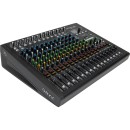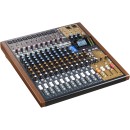TASCAM Model 16 vs Mackie Onyx16: Which Mixer is Right for You?
The TASCAM Model 16 Hybrid 14-Channel Mixer is a versatile piece of equipment that combines a mixer, multitrack recorder, and USB audio interface into one compact unit. This mixer is designed for musicians, bands, and home studios, offering recording, mixing, and playback capabilities. It features 14 channels with ten microphone preamps and allows for multitrack recording onto an SD card with 16 tracks. The Model 16 also supports USB audio interface functionality, making it easy to connect to a computer for recording or playback. Additionally, it includes an integrated effects processor, Bluetooth input, and a user-friendly layout that simplifies live and studio mixing tasks.
On the other hand, the Mackie Onyx16 Analog Mixer is a robust analog mixer that focuses on high-quality sound and durability. It offers 16 channels, featuring Mackie's renowned Onyx preamps, which provide pristine audio quality with low noise and high headroom. The mixer is equipped with a 4-band EQ on each channel, allowing for detailed sound sculpting. The Onyx16 does not have multitrack recording capabilities or built-in effects but is designed for users who prioritize analog sound quality and reliability. It includes a USB interface for stereo recording and playback, making it suitable for both live performances and studio environments.
In summary, the TASCAM Model 16 is ideal for users seeking an all-in-one solution with multitrack recording, effects, and versatility in both live and studio settings. It is particularly beneficial for those who need to record multiple tracks simultaneously. Conversely, the Mackie Onyx16 is better suited for those who value sound quality and prefer working with an analog mixer that offers essential features without the complexity of digital options. Both mixers offer USB connectivity, but the choice between them ultimately depends on whether you prioritize multitrack recording and effects (TASCAM Model 16) or high-quality analog sound (Mackie Onyx16).
In the following sections, we will delve into a comprehensive comparison of the TASCAM Model 16 Hybrid 14-Channel Mixer, Multitrack Recorder, and USB Audio Interface with the Mackie Onyx16 Analog Mixer. This article will meticulously examine their specifications, highlighting the strengths and weaknesses of each product to aid you in making an informed decision.
In-Depth Specifications, Advantages, and Disadvantages
| User Rating Based on Analysis of Reviews | |
|---|---|
|
Show More |
| Pros: | |
|---|---|
|
|
| Cons: | |
|---|---|
|
|
| Find Best Price | Find Best Price |
| Connectivity | |
|---|---|
| Phantom Power | |
| +48 V (Applied to All Inputs) | 48 V, Selectable On/Off |
The TASCAM Model 16 Hybrid offers a robust set of features with its 14 channels that include 10 XLR 3-Pin Balanced Mic Inputs and 12 1/4" TRS Balanced Line Inputs. It also provides a variety of outputs including 2 XLR Main Outputs, 3 Balanced Aux Outputs, and a 1/4" TRS Headphone Output. Additionally, it includes Bluetooth connectivity for wireless audio streaming, making it versatile for different applications.Show More
In contrast, the Mackie Onyx16 features 12 XLR 3-Pin Balanced Mic Inputs and 8 1/4" TRS Balanced/Unbalanced Line Inputs. It also offers 2 XLR Balanced Stereo Main Outputs along with 2 Balanced/Unbalanced Stereo Monitor Outputs. However, it lacks any digital I/O capabilities and does not support Bluetooth, which limits its connectivity options compared to the TASCAM model.
Both mixers provide 48 V Phantom Power for condenser microphones; however, the TASCAM Model 16 has a USB-B connection for digital audio interfacing, allowing for easy integration with computers and recording software. The Mackie Onyx16, while robust in analog features, does not have any digital audio features, making it less suitable for modern digital workflows.
Overall, while the TASCAM Model 16 stands out with its hybrid capabilities, including multitrack recording and USB audio interface functionality, the Mackie Onyx16 excels in its solid analog construction and straightforward operation. The choice between them will depend on your specific needs for digital integration versus pure analog performance.
| Power | |
|---|---|
| AC Input Power | |
| 100 to 240 VAC, 50 / 60 Hz | 100 to 240 VAC, 50 / 60 Hz |
| Power Consumption | |
| 45 W | 40 W |
The TASCAM Model 16 Hybrid 14-Channel Mixer offers a versatile setup with a power requirement of 100 to 240 VAC, operating at 50 / 60 Hz. It consumes 40 W of power, making it slightly more efficient compared to some competitors in its class. This model is designed not only as a mixer but also incorporates multitrack recording capabilities and functions as a USB audio interface, catering to a wide range of audio production needs.Show More
In comparison, the Mackie Onyx16 Analog Mixer also supports a power input of 100 to 240 VAC at 50 / 60 Hz. However, it has a higher power consumption of 45 W, which may justify its additional features and robust analog design. The Onyx16 is specifically engineered for high-quality analog mixing, providing professional-grade sound and build quality, which makes it a strong contender among analog mixers.
In summary, while both mixers are capable of functioning within the same voltage range and frequency, the TASCAM Model 16 presents a lower power consumption of 40 W and includes extensive recording capabilities, whereas the Mackie Onyx16 stands out with its higher consumption of 45 W and emphasis on analog performance. This makes the TASCAM model more suited for those needing a hybrid device, whereas the Mackie mixer appeals to users focused on analog sound quality.
| Physical | |
|---|---|
| Dimensions | |
| 18.7 x 14 x 4.5" / 475 x 355.6 x 114.3 mm | 16.9 x 18.2 x 4.4" / 43 x 46.3 x 11.3 cm (Including Controls and Protrusions) |
| Weight | |
| 15.2 lb / 6.9 kg | 15.4 lb / 7.0 kg |
The TASCAM Model 16 Hybrid is a versatile 14-channel mixer that combines the functions of a multitrack recorder and a USB audio interface. It operates efficiently within a temperature range of 41 to 95°F / 5 to 35°C. The dimensions of the TASCAM Model 16 are 16.9 x 18.2 x 4.4" / 43 x 46.3 x 11.3 cm, making it suitable for various setups, and it weighs 15.4 lb / 7.0 kg, which provides a sturdy yet portable option for users.Show More
On the other hand, the Mackie Onyx16 Analog Mixer is also a robust option, notably rack mountable, which adds to its versatility in different environments. Its dimensions are 18.7 x 14 x 4.5" / 475 x 355.6 x 114.3 mm, making it slightly larger than the TASCAM Model 16. The Mackie Onyx16 has a comparable weight of 15.2 lb / 6.9 kg, offering a lightweight solution for mobile applications.
| Packaging Info | |
|---|---|
| Package Weight | |
| 20.28 lb | 22.135 lb |
| Box Dimensions (LxWxH) | |
| 22.8 x 17.3 x 7.6" | 23 x 20 x 8.8" |
The TASCAM Model 16 Hybrid 14-Channel Mixer has a package weight of 22.135 lb and comes in box dimensions of 23 x 20 x 8.8 inches. This makes it slightly heavier and bulkier than its competitor, the Mackie Onyx16.Show More
In contrast, the Mackie Onyx16 Analog Mixer features a package weight of 20.28 lb and box dimensions of 22.8 x 17.3 x 7.6 inches. This indicates that the Onyx16 is more lightweight and compact, making it potentially easier to transport and set up for live performances or studio use.
Overall, while both mixers offer robust features suited for various audio applications, the TASCAM Model 16 is slightly heavier and larger, while the Mackie Onyx16 offers a more portable and lightweight design.
| Customer Images | |
|---|---|
|
|
|








